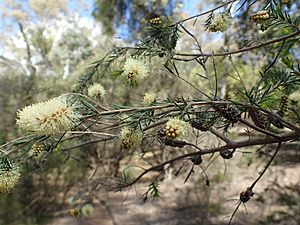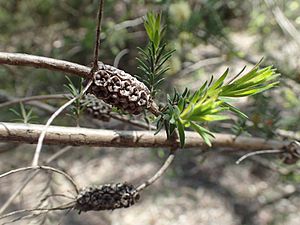Melaleuca incana subsp. tenella facts for kids
Quick facts for kids Melaleuca incana subsp. tenella |
|
|---|---|
 |
|
| Melaleuca incana subsp. tenella foliage and flowers | |
| Scientific classification |
|
| Kingdom: | Plantae |
| Clade: | Tracheophytes |
| Clade: | Angiosperms |
| Clade: | Eudicots |
| Clade: | Rosids |
| Order: | Myrtales |
| Family: | Myrtaceae |
| Genus: | Melaleuca |
| Species: | |
| Subspecies: |
M. i. subsp. tenella
|
| Trinomial name | |
| Melaleuca incana subsp. tenella (Benth.) Barlow
|
|
Melaleuca incana subsp. tenella is a special plant. It belongs to the myrtle family, called Myrtaceae. This plant is endemic to the south coast of Western Australia. This means you can only find it growing naturally in that area.
It used to be known as Melaleuca tenella. But in 1998, scientists decided it was a subspecies. A subspecies is like a close relative within the same species. It is very similar to M. incana subsp. incana. However, it has some differences. These include its overall shape, the size and form of its leaves, when it flowers, and where it grows.
What it Looks Like
Melaleuca incana subsp. tenella is usually a tall, spreading bush. Sometimes, it can even grow into a small tree. It can reach about 5 metres (20 ft) (about 16 feet) tall. Its outer branches are thin.
The leaves grow in pairs, one across from the other. Sometimes, they grow in rings of three. They are curved and packed closely along the small branches. Each leaf is about 3.5–9 millimetres (0.1–0.4 in) long. They are also very narrow, about 0.5–1.1 millimetres (0.02–0.04 in) wide. The leaves and young branches have fine, soft hairs. This makes the plant look a bit grey.
The flowers grow in spikes. These spikes are usually at the ends of branches. The branches keep growing even after the flowers bloom. Each spike has between 6 and 55 individual flowers. A spike can be up to 30 millimetres (1 in) long and 15 millimetres (0.6 in) wide. The flowers can be white, creamy white, or yellow.
The petals are small, about 0.7–2.0 millimetres (0.03–0.08 in) long. They fall off as the flower gets older. The stamens are the parts that hold pollen. They are grouped into five bundles around the flower. Each bundle has between 3 and 11 stamens. This plant mostly flowers in October. After flowering, it produces woody capsules. These capsules are about 3–4 millimetres (0.1–0.2 in) across. They form cup-shaped clusters up to 20 millimetres (0.8 in) long.
How it Got its Name
The plant was first described in 1867. This happened in a book called Flora Australiensis. It was first called Melaleuca tenella. A person named George Maxwell collected the first sample. He found it in wet soil near the Phillips River.
In 1998, scientists looked closely at the Melaleuca group of plants. They decided that Melaleuca tenella was actually a subspecies. So, its name was changed to Melaleuca incana subsp. tenella. The word "tenella" comes from the Latin word tener. This means "soft," "delicate," or "tender." This name describes how the first plant sample looked.
Where it Grows
Melaleuca incana subsp. tenella grows near the coast of Western Australia. You can find it between the Esperance area and Cape Arid. These areas are part of the Esperance Plains and Mallee regions. This plant likes to grow in sandy, swampy places.


